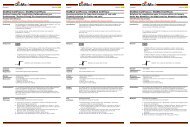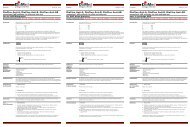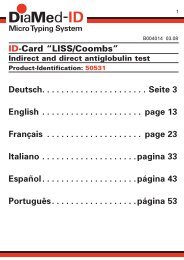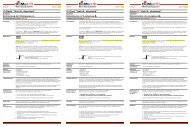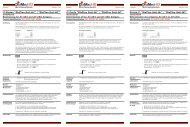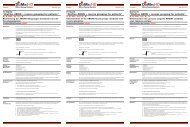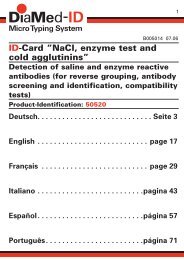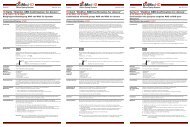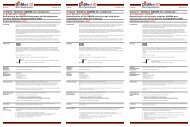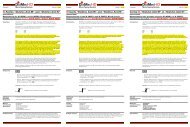ID-Cards “Anti-Lua” / “Anti-Lub”
ID-Cards “Anti-Lua” / “Anti-Lub”
ID-Cards “Anti-Lua” / “Anti-Lub”
- No tags were found...
Create successful ePaper yourself
Turn your PDF publications into a flip-book with our unique Google optimized e-Paper software.
Français B007351 07.07 English B007351 07.07 Deutsch B007351 07.07<br />
Contrôles<br />
Des échantillons positifs et négatifs connus devront être inclus en concordance avec les<br />
réglementations régissant l‘assurance qualité.<br />
Controls<br />
Known positive and negative samples should be included in accordance with the relevant<br />
guidelines of quality assurance.<br />
Kontrollen<br />
Bekannte Antigen-positive und -negative Erythrozyten sollten in Übereinstimmung mit<br />
den gültigen Richtlinien zur Qualitätssicherung mitgeführt werden.<br />
Méthode<br />
Ne pas utiliser les cartes <strong>ID</strong> présentant des signes de desséchement, des bulles d‘air dans<br />
le gel, un système de fermeture endommagé, des goutelettes de gel ou de surnageant<br />
sur les paroies supérieures des micotubes ou sur la face interne de la languette<br />
d‘aluminium.<br />
Test procedure<br />
Do not use <strong>ID</strong>-<strong>Cards</strong> which show signs of drying, have bubbles, damaged seals, drops of<br />
gel or supernatant in the upper part of the microtubes or on the underside of the<br />
aluminium foil.<br />
Testdurchführung<br />
Keine <strong>ID</strong>-Karten benutzen mit Anzeichen von Austrocknung, Luftblasen, beschädigter<br />
Versiegelung oder Tropfen des Gels bzw. des Überstandes im oberen Teil der<br />
Mikrokammer oder auf der Unterseite der Versiegelung.<br />
Ramener les cartes-<strong>ID</strong> à température ambiante avant utilisation.<br />
Allow <strong>ID</strong>-<strong>Cards</strong> to reach room temperature before use.<br />
<strong>ID</strong>-Karten vor Gebrauch auf Raumtemperatur bringen.<br />
1. Identifier la carte <strong>ID</strong> avec le numéro d’enregistrement unique du patient ou donneur /<br />
toutes identifications pertinentes.<br />
2. Décoller la languette d‘aluminium des microtubes nécessaires en tenant la carte <strong>ID</strong> en<br />
position verticale.<br />
3. Distribuer 10 ou 12,5 µL de la suspension d’hématies du patient dans le microtube<br />
concerné.<br />
4. Centrifuger la carte-<strong>ID</strong> 10 minutes dans l’<strong>ID</strong>-Centrifuge.<br />
5. Lire et noter les réactions.<br />
1. Identify the <strong>ID</strong>-Card with the unique patient or donor number/details as appropriate.<br />
2. Remove the aluminium foil from as many microtubes as required by holding the <strong>ID</strong><br />
card in the upright position.<br />
3. Add 10 or 12,5 µL of the red cell suspension to the appropriate microtubes.<br />
4. Centrifuge the <strong>ID</strong>-Card for 10 minutes in the <strong>ID</strong>-Centrifuge.<br />
5. Read and record the reactions.<br />
1. Die <strong>ID</strong>-Karte mit den Patienten- oder Spenderdaten beschriften.<br />
2. Aluminiumfolie von den benötigten Mikroröhrchen in aufrechter Kartenposition<br />
entfernen.<br />
3. 10 oder 12,5 µL der Erythrozytensuspension in die entsprechenden Mikroröhrchen der<br />
<strong>ID</strong>-Karte pipettieren.<br />
4. <strong>ID</strong>-Karte 10 Minuten mit der <strong>ID</strong>-Zentrifuge zentrifugieren.<br />
5. Reaktionen ablesen und aufzeichnen.<br />
Interprétation<br />
des résultats<br />
A) Principe [2]<br />
Positif: Hématies agglutinées formant une ligne rouge à la surface du gel ou des<br />
agglutinats dispersés dans le gel.<br />
Négatif: Hématies en culot compact au fond du microtube.<br />
Interpretation of<br />
results<br />
A) Principle [2]<br />
Positive: Agglutinated cells forming a red line on the surface of the gel or<br />
agglutinates dispersed in the gel.<br />
Negative: Compact button of cells on the bottom of the microtube.<br />
Interpretation<br />
der Ergebnisse<br />
A) Prinzip [2]<br />
Positiv: Agglutinierte Erythrozyten bilden eine rote Linie auf dem Gel oder sind im<br />
Gel verteilt.<br />
Negativ: Kompaktes Erythrozytensediment am Boden des Mikroröhrchens.<br />
B) Réactions pour Lu u a et Lu b<br />
B) Reactions for Lu u a and Lu b<br />
B) Reaktionen für Lu a und Lu b<br />
• Des réactions positives de + à ++++ indiquent la présence de l’antigène correspondant.<br />
• Positive reactions of + to ++++ indicate presence of the corresponding antigen.<br />
• Positive Reaktionen (+ bis ++++) bedeuten Nachweis des entsprechenden Antigens.<br />
• Des réactions positives apparaissent souvent comme une double population.<br />
Cependant, une double population dans le même microtube peut également indiquer<br />
la présence d’hématies positives et négatives de l’antigène correspondant (par<br />
exemple si la configuration du sang transfusé était différente du sang de patient).<br />
• Positive reactions often appear as a double population. However, a double population<br />
may also indicate the presence of cells positive and negative for the corresponding<br />
antigen (e.g. Post-transfusion, if the antigen configuration of the transfused blood was<br />
different from the patient’s).<br />
• Positive Reaktionen zeigen sich oft als Doppelpopulationen. Trotzdem kann eine<br />
Doppelpopulation in dem gleichen Mikroröhrchen das Vorliegen von<br />
Antigen-negativen und -positiven Erythrozyten anzeigen (z.B. wenn die<br />
Antigenkonfiguration des transfundierten Blutes verschieden war zum Patienten).<br />
• Des réactions fortement positive (++++) sont très rares.<br />
• Strong ++++ reactions are very rare.<br />
• Starke Reaktionen (++++) sind äusserst selten.<br />
• Des réactions négatives indiquent l’absence de l’antigène correspondant.<br />
• Negative reactions indicate absence of the corresponding antigen.<br />
• Negative Reaktionen bedeuten Abwesenheit des entsprechenden Antigens.<br />
Limites<br />
a) Les cartes-<strong>ID</strong> présentant des bulles d‘air dans le gel ou des goutelettes dans la partie<br />
supérieur des microtubes ou sur la languette métallique doivent être centrifugées<br />
avant utilisation.<br />
b) Des hématies présentant, in vivo ou in vitro, une polyagglutinabilité due à un<br />
cryptoantigène, tel que l’antigène T, peuvent réagir avec tous les antisérums humains.<br />
Dans ce cas, des investigations supplémentaires sont nécessaires.<br />
c) Des contaminations, bactériennes ou autres, du matériel utilisé peuvent provoquer<br />
des résultats faussement positifs ou faussement négatifs.<br />
d) Des résidus de fibrine dans la suspension d’hématies peuvent emprisonner quelques<br />
hématies non agglutinées, formant ainsi une fine ligne rose à la surface du gel, alors<br />
que la plupart des hématies sont dans le fond du microtube après centrifugation.<br />
e) L’observation stricte des méthodes et l’emploi de l’équipement recommandé sont<br />
essentiels. L’équipement doit être régulièrement contrôlé selon les procédures des<br />
GLP.<br />
f) L’utilisation de diluants autres que l’<strong>ID</strong>-Diluent 1 peut modifier les résultats.<br />
g) Des suspensions d’hématies trop concentrées ou trop diluées peuvent provoquer des<br />
résultats aberrants.<br />
Limitations<br />
a) <strong>ID</strong> cards which show air bubbles in the gel or drops in the upper part of the microtubes<br />
and/or the seal, must be centrifuged before use.<br />
b) Cells that have become polyagglutinable, due to cryptoantigen exposure, e.g. T<br />
antigen, either in vivo or in vitro, may react with all human antisera. Further investigation<br />
of such reactions is required.<br />
c) Bacterial or other contamination of materials used can cause false positive or false<br />
negative results.<br />
d) Fibrin residues in the red cell suspension may trap non-agglutinated cells presenting a<br />
fine pink line on top of the gel while most of the cells are on the bottom of the<br />
microtube after centrifugation.<br />
e) Strict adherence to the procedures and recommended equipment is essential. The<br />
equipment should be checked regularly according to GLP procedures.<br />
f) Use of suspension solutions for red cells other than <strong>ID</strong>-Diluent 1 may modify the<br />
reactions.<br />
g) Too heavy or too weak red cell suspensions can cause aberrant reactions.<br />
Einschränkungen<br />
a) <strong>ID</strong>-Karten mit Luftblasen im Gel oder Tropfen im oberen Bereich der Mikrokammern<br />
und/oder Versiegelung müssen vor Gebrauch zentrifugiert werden.<br />
b) Polyagglutinable Erythrozyten, z.B. infolge T-Aktivierung, sowohl in vivo wie auch in<br />
vitro, können mit allen humanen Testseren reagieren. Weitere Untersuchungen sind<br />
angezeigt.<br />
c) Bakterielle oder andere Kontaminationen des verwendeten Materials können falsch<br />
positive oder falsch negative Ergebnisse verursachen.<br />
d) Fibrinreste in der Erythrozytensuspension können nicht-agglutinierte Zellen verkleben,<br />
die sich als feine rosa Linie auf der Geloberfläche darstellen, während die meisten<br />
Zellen nach Zentrifugation am Boden der Mikroröhrchen ein kompaktes Sediment<br />
bilden.<br />
e) Striktes Befolgen der Anleitungen und Verwendung des erforderlichen Arbeitmaterials<br />
sind unerlässlich. Das Arbeitsmaterial sollte regelmässig entsprechend der<br />
GLP-Richtlinien überprüft werden.<br />
f) Der Gebrauch anderer Lösungen als <strong>ID</strong>-Diluent 1 für die Erythrozytensuspensionen<br />
kann die Reaktionen beeinflussen.<br />
g) Zu starke oder zu schwache Erythrozytensuspensionen können abnormale Reaktionen<br />
hervorrufen.<br />
Remarques Une centrifugation répétée de la carte-<strong>ID</strong> n’influence pas la performance du réactif. Remarks Repeated centrifugation of the <strong>ID</strong>-Card does not affect the performance of the product. Anmerkungen Wiederholtes Zentrifugieren der <strong>ID</strong>-Karte hat keinen Einfluss auf die Qualität des<br />
Produktes.<br />
Bibliographie<br />
1. Mollison, P.L., Engelfriet, C.P., Contreras, M.: Blood Transfusion in Clinical Medicine,<br />
10 th ed. 1997; Blackwell Scientific Publications, Oxford.<br />
2. Lapierre, Y., Rigal, D., Adam, J. et al.: The gel test: A new way to detect red cell<br />
antigen-antibody reactions. Transfusion 1990: 109-113.<br />
3. Technical Manual: 11 th ed. 1993; American Association of Blood Banks.<br />
Bibliography<br />
1. Mollison, P.L., Engelfriet, C.P., Contreras, M.: Blood Transfusion in Clinical Medicine,<br />
10 th ed. 1997; Blackwell Scientific Publications, Oxford.<br />
2. Lapierre, Y., Rigal, D., Adam, J. et al.: The gel test: A new way to detect red cell<br />
antigen-antibody reactions. Transfusion 1990: 109-113.<br />
3. Technical Manual: 11 th ed. 1993; American Association of Blood Banks.<br />
Literatur<br />
1. Mollison, P.L., Engelfriet, C.P., Contreras, M.: Blood Transfusion in Clinical Medicine,<br />
10 th ed. 1997; Blackwell Scientific Publications, Oxford.<br />
2. Lapierre, Y., Rigal, D., Adam, J. et al.: The gel test: A new way to detect red cell<br />
antigen-antibody reactions. Transfusion 1990: 109-113.<br />
3. Technical Manual: 11 th ed. 1993; American Association of Blood Banks.<br />
Produits Carte-<strong>ID</strong> <strong>“Anti</strong>-Lu a 1 x 12 . . . . . . . . . . . . . . . . . . .REF 007351<br />
Carte-<strong>ID</strong> <strong>“Anti</strong>-Lu b 1 x 12 . . . . . . . . . . . . . . . . . . .REF 007361<br />
Products <strong>ID</strong>-Card <strong>“Anti</strong>-Lu a ” 1 x 12 . . . . . . . . . . . . . . . . . . .REF 007351<br />
<strong>ID</strong>-Card <strong>“Anti</strong>-Lu b ” 1 x 12 . . . . . . . . . . . . . . . . . . .REF 007361<br />
Produkte <strong>ID</strong>-Karte <strong>“Anti</strong>-Lu a ” 1 x 12 . . . . . . . . . . . . . . . . . . .REF 007351<br />
<strong>ID</strong>-Karte <strong>“Anti</strong>-Lu b ” 1 x 12 . . . . . . . . . . . . . . . . . . .REF 007361<br />
Ces produits sont garantis quant à leurs propriétés et qualités stipulées sur l’étiquette<br />
et dans le mode opératoire. Le fabricant décline toute responsabilité pour les cas où ces<br />
produits seraient employés ou vendus à d’autres usages.<br />
These products are guaranteed to perform as described on the label and in the<br />
instruction sheet. The manufacturer declines all responsibility arising out of the use or<br />
sale of these products in any way or for any purpose other than those described therein.<br />
Für diese Produkte wird nur Garantie übernommen, wenn sie gemäss den Angaben auf<br />
dem Etikett und der Anwendungsvorschrift verwendet werden. Jegliche Verantwortung<br />
wird ausdrücklich abgelehnt, wenn das Präparat für andere Zwecke gebraucht oder<br />
verkauft wird.<br />
DiaMed SA, 1785 Cressier s/Morat, Suisse DiaMed AG, 1785 Cressier s/Morat, Switzerland DiaMed AG, 1785 Cressier s/Morat, Schweiz




